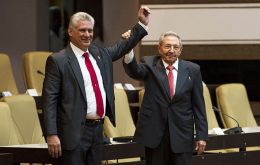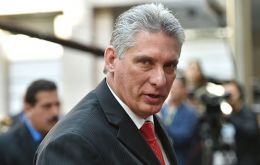MercoPress. South Atlantic News Agency
Tag: Comunist Party Cuba
-
Thursday, April 19th 2018 - 22:24 UTC
Miguel Díaz-Canel becomes the new president of Cuba: there is no chance of a Trojan horse

Miguel Díaz-Canel has been ratified on Thursday by the National Assembly of Cuba as the new president of the Council of State, the country's first leader in practice. The parliament ratified the former vice president with 99.83% of the votes of the deputies present. Diaz-Canel replaces the General Raúl Castro, who retires from power after 12 years at the head of the country. However, the new president clarified that Raúl Castro “will lead the most important decisions” for the country.
-
Thursday, April 19th 2018 - 07:49 UTC
The Castro dynasty begins its 'controlled' exit under president Diaz-Canel

An era will end in Communist-dynastic Cuba on Thursday when President Raul Castro retires, handing over the reins to his right hand man Miguel Diaz-Canel, born the year after brothers Fidel and Raul led their 1959 leftist revolution. However after nearly 60 years of Castro rule, the change is not expected to herald sweeping reforms to the island’s state-run economy and one-party system, one of the last in the world.
-
Wednesday, April 18th 2018 - 07:37 UTC
Who is Miguel Díaz-Canel who is expected to lead Cuba after 60 years of the Castro dynasty

Cuba is set to undergo a historic shift this week, elevating a relatively unknown Communist Party official to replace retiring President Raúl Castro. But who is Miguel Díaz-Canel? And what does his ascension to the top of Cuba's government mean for a country that has been run by the Castro brothers for nearly 60 years?
